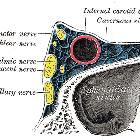Sinus-cavernosus-Syndrom

Cavernous sinus syndromes refer to constellations of clinical signs and symptoms referable to pathology within or adjacent to the cavernous sinus.
Clinical presentation
Patients present with multiple unilateral cranial neuropathies involving any combination of the following:
- ophthalmoplegia (cranial nerves III, IV, or VI), most commonly presenting as diplopia
- facial sensory loss (cranial nerves V1 and V2)
- Horner syndrome (oculosympathetic fibers)
Pain can occur, especially with inflammatory processes.
Additional symptoms may be vascular in origin:
- chemosis
- proptosis
Pathology
Causes are diverse and may be organized by surgical sieve:
- neoplastic
- secondary (direct invasion, perineural spread, or hematogenous spread)
- head and neck tumors, e.g. nasopharyngeal carcinoma, adenoid cystic carcinoma, squamous cell carcinoma, juvenile angiofibroma
- pituitary tumors, e.g. pituitary adenoma, craniopharyngioma
- skull base tumors, e.g. chordoma, chondrosarcoma
- distant metastases, e.g. lung cancer, breast cancer
- hematolymphoid tumors, e.g. lymphoma, plasmacytoma, leukemia
- histiocytoses, e.g. Langerhans cell histiocytosis, Rosai-Dorfman disease
- primary
- secondary (direct invasion, perineural spread, or hematogenous spread)
- autoinflammatory
- Tolosa-Hunt syndrome (idiopathic inflammation)
- inflammatory pseudotumor of the skull base
- granulomatosis with polyangiitis (Wegener's)
- sarcoidosis
- hypertrophic pachymeningitis
- infection
- bacterial
- meningitis
- cavernous sinus thrombophlebitis (septic cavernous sinusitis)
- actinomycosis
- fungal
- viral
- herpes zoster ophthalmicus
- bacterial
- vascular
- congenital/developmental
- traumatic
See also
Siehe auch:

 Assoziationen und Differentialdiagnosen zu Sinus-cavernosus-Syndrom:
Assoziationen und Differentialdiagnosen zu Sinus-cavernosus-Syndrom:

